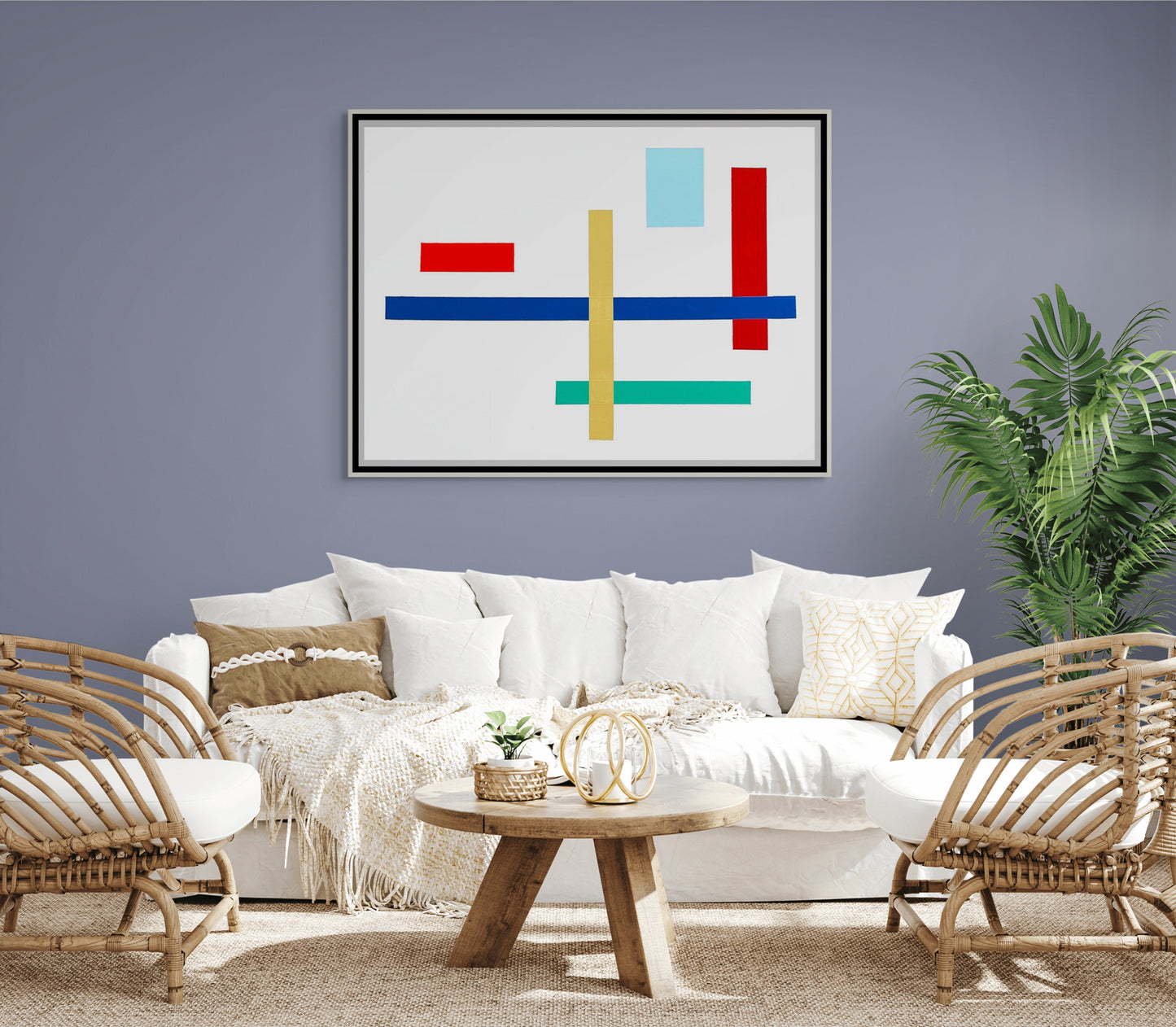Prayer of Thanks, 30" x 40"
Prayer of Thanks, 30" x 40"
See more paintings from the Floating Color Collection.

James Nowak’s Prayer of Thanks, from the Floating Color Collection, embodies the artist’s distinctive exploration of abstraction through geometry, color, and spatial arrangement. With its verticals and horizontals intersecting like a minimalist cross structure, the painting carries spiritual undertones that move beyond pure form. As the title suggests, the work frames geometry as a meditative gesture, evoking both gratitude and transcendence.
The composition is defined by intersecting bars and rectangles, organized around a central vertical dark blue line. This vertical acts as an axis of stillness, recalling the upright figure or the symbolic posture of prayer. Crossing it, a golden-yellow horizontal bar stabilizes the structure, echoing the calm and balance often associated with contemplation.
Around this framework, other shapes animate the field:
- A bright red rectangle on the upper right introduces energy and passion, almost like a burst of emotion.
- A lighter sky-blue rectangle floats to the right, balancing the intensity of the red with serenity.
- A green vertical on the left creates an echo of growth and renewal.
- A lower red bar grounds the vertical axis, reinforcing stability.
The arrangement is asymmetrical yet carefully balanced, suggesting that gratitude itself is not static but dynamic, emerging from the tension of different forces held in harmony.
Nowak employs a palette of bold, flat colors, each carrying symbolic weight:
- Blue (dark and light) conveys stillness, depth, and transcendence.
- Red injects intensity, representing vitality, passion, or human emotion within the spiritual act.
- Yellow-gold introduces warmth and radiance, suggesting light, divinity, or a sense of blessing.
- Green evokes renewal and growth; qualities often tied to thankfulness and life.
The white background amplifies the floating quality of the shapes, ensuring they resonate as luminous presences in open space rather than fixed architectural elements.
In keeping with the Floating Color Collection, the forms are suspended in a white void, weightless and timeless. Unlike Tall Building or The Fence, which lean toward architectural metaphor, Prayer of Thanks evokes a spiritual register. The central vertical and intersecting horizontals form a loose cruciform structure, suggesting not only physical balance but also symbolic reverence.
The floating rectangles around the central cross-like figure can be read as extensions of thought, fragments of light, or offerings of gratitude dispersed into space. The painting thus transforms abstraction into a meditative visual prayer.
The title Prayer of Thanks guides interpretation toward a spiritual and emotional reading. The balance of color and form reflects the act of giving thanks—an alignment of energy, emotion, and clarity. The red, yellow, and blue interplay can be read as a triad of human emotion, divine radiance, and contemplative stillness.
The composition suggests that gratitude is not passive but active—a dynamic balance of forces. By anchoring the work in the central vertical, Nowak emphasizes both inner stability and upward orientation, resonating with the gesture of prayer itself.
Nowak’s abstraction recalls the clarity of Piet Mondrian and the spiritual geometry of Kazimir Malevich, yet it avoids rigid systems. Instead of striving for universal order, Prayer of Thanks maintains looseness and improvisation, closer in spirit to the lyrical freedom of Matisse’s cut-outs.
The painting situates itself in the lineage of artists who sought transcendence through abstraction—constructing meaning not from representation but from the meditative power of color and geometry.
James Nowak’s Prayer of Thanks transforms the formal vocabulary of rectangles and bars into a meditative composition of gratitude and balance. Through bold color contrasts, floating forms, and a cruciform central structure, the painting evokes both architectural stability and spiritual transcendence. It exemplifies Nowak’s ability to infuse abstraction with emotional and symbolic depth, reminding us that even in minimal forms, profound gestures of thanks can be expressed.

